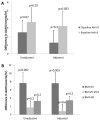Association of incident cardiovascular disease with progression of sleep-disordered breathing
- PMID: 21403097
- PMCID: PMC3707123
- DOI: 10.1161/CIRCULATIONAHA.110.974022
Association of incident cardiovascular disease with progression of sleep-disordered breathing
Abstract
Background: Prospective data suggest that sleep-disordered breathing enhances risk for incident and recurrent cardiovascular disease (CVD). However, a reverse causal pathway whereby incident CVD causes or worsens sleep-disordered breathing has not been studied.
Methods and results: A total of 2721 Sleep Heart Health Study participants (mean age 62, standard deviation=10 years; 57% women; 23% minority) without CVD at baseline underwent 2 polysomnograms 5 years apart. Incident CVD events, including myocardial infarction, congestive heart failure, and stroke, were ascertained and adjudicated. The relation of incident CVD to change in apnea-hypopnea index between the 2 polysomnograms was tested with general linear models, with adjustment for age, sex, race, study center, history of diabetes mellitus, change in body mass index, change in neck circumference, percent sleep time spent in supine sleep, and time between the 2 polysomnograms. Incident CVD occurred in 95 participants between the first and second polysomnograms. Compared with participants without incident CVD, those with incident CVD experienced larger increases in apnea-hypopnea index between polysomnograms. The difference in adjusted mean apnea-hypopnea index change between subjects with and without incident CVD was 2.75 events per hour (95% confidence interval, 0.26 to 5.24; P=0.032). This association persisted after subjects with central sleep apnea were excluded. Compared with participants without incident CVD, participants with incident CVD had greater increases in both mean obstructive and central apnea indices, by 1.75 events per hour (95% confidence interval, 0.10 to 1.75; P=0.04) and by 1.07 events per hour (95% confidence interval, 0.40 to 1.74; P=0.001), respectively.
Conclusions: In a diverse, community-based sample of middle-aged and older adults, incident CVD was associated with worsening sleep-disordered breathing over 5 years.
Figures

Comment in
-
Sleep-disordered breathing and heart disease: is it one big, vicious loop?Circulation. 2011 Mar 29;123(12):1265-6. doi: 10.1161/CIRCULATIONAHA.111.018945. Epub 2011 Mar 14. Circulation. 2011. PMID: 21403101 No abstract available.
References
-
- Young T, Shahar E, Nieto FJ, Redline S, Newman AB, Gottlieb DJ, Walsleben JA, Finn L, Enright P, Samet JM. Predictors of sleep-disordered breathing in community-dwelling adults: the Sleep Heart Health Study. Arch Intern Med. 2002;162:893–900. - PubMed
-
- Newman A, Foster G, Givelbert R, Nieto FJ, Redline S, Young T. Progression and regression of sleep disordered breathing with changes in weight. Arch Intern Med. 2005;165:2408–2413. - PubMed
-
- Shahar E, Whitney CW, Redline S, Lee ET, Newman AB, Javier Nieto F, O’Connor GT, Boland LL, Schwartz JE, Samet JM. Sleep-disordered breathing and cardiovascular disease: cross-sectional results of the Sleep Heart Health Study. Am J Respir Crit Care Med. 2001;163:19–25. - PubMed
-
- De Olazabal JR, Miller MJ, Cook WR, Mithoefer JC. Disordered breathing and hypoxia during sleep in coronary artery disease. Chest. 1982;82:548–552. - PubMed
-
- Koehler U, Schafer H. Is obstructive sleep apnea a risk factor for myocardial infarction and cardiac arrhythmias in patients with coronary heart disease. Sleep. 1996;19:283–286. - PubMed
Publication types
MeSH terms
Grants and funding
- R01 HL089467/HL/NHLBI NIH HHS/United States
- U01HL53937/HL/NHLBI NIH HHS/United States
- U01 HL053916/HL/NHLBI NIH HHS/United States
- U01HL64360/HL/NHLBI NIH HHS/United States
- U01 HL063463/HL/NHLBI NIH HHS/United States
- U01HL53938/HL/NHLBI NIH HHS/United States
- U01 HL053938/HL/NHLBI NIH HHS/United States
- U01 HL053941/HL/NHLBI NIH HHS/United States
- U01 HL053937/HL/NHLBI NIH HHS/United States
- R01 HL086862/HL/NHLBI NIH HHS/United States
- U01HL53934/HL/NHLBI NIH HHS/United States
- U01 HL064360/HL/NHLBI NIH HHS/United States
- U01HL63429/HL/NHLBI NIH HHS/United States
- U01HL53931/HL/NHLBI NIH HHS/United States
- U01HL53941/HL/NHLBI NIH HHS/United States
- U01 HL053934/HL/NHLBI NIH HHS/United States
- U01HL53916/HL/NHLBI NIH HHS/United States
- U01 HL063429/HL/NHLBI NIH HHS/United States
- U01HL53940/HL/NHLBI NIH HHS/United States
- U01HL63463/HL/NHLBI NIH HHS/United States
- U01 HL053931/HL/NHLBI NIH HHS/United States
LinkOut - more resources
Full Text Sources
Other Literature Sources
Medical

